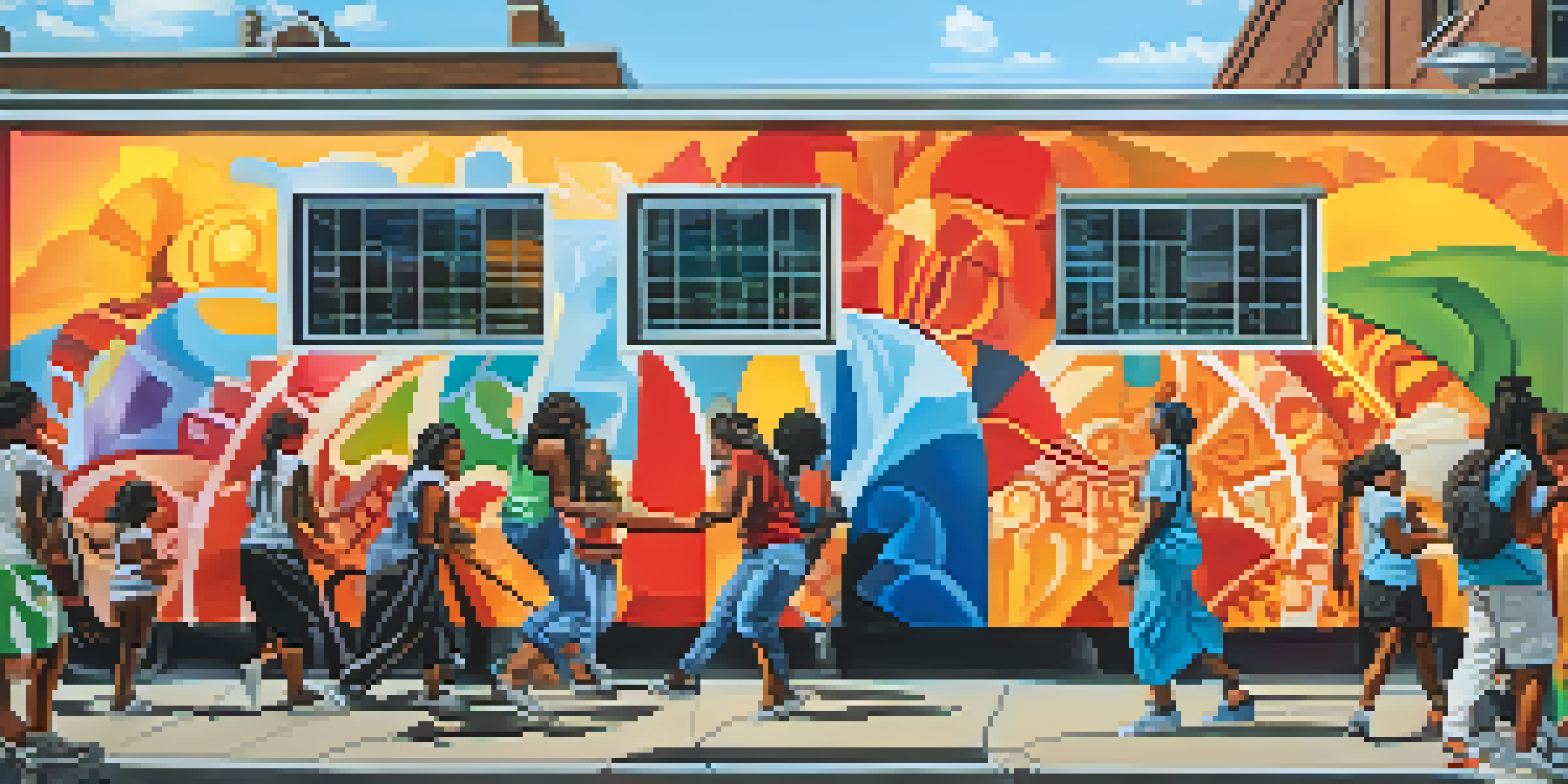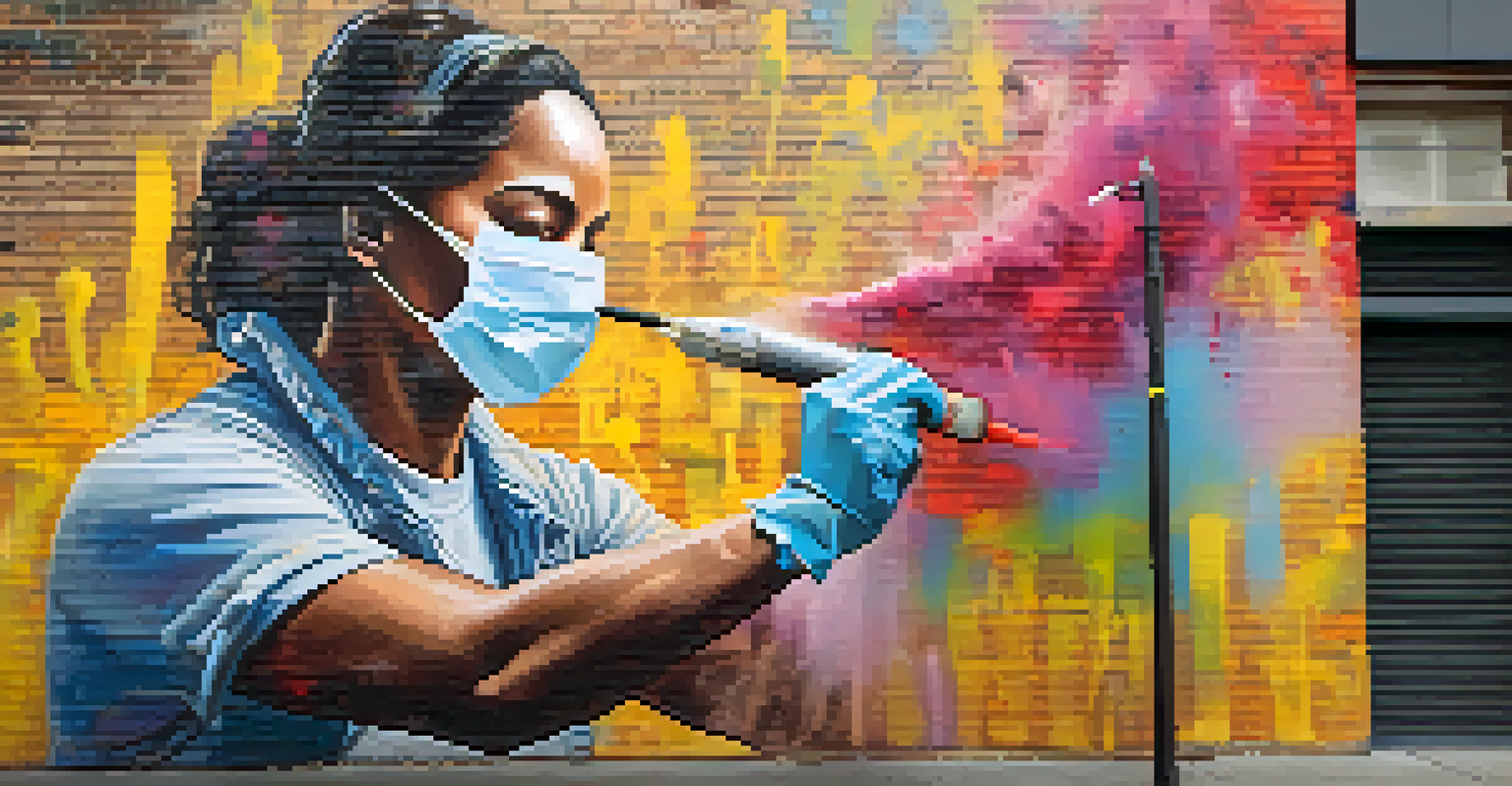Authenticity in Street Art: A Cultural Perspective

Understanding the Roots of Street Art
Street art has deep roots in urban culture, emerging as a voice for the marginalized and a canvas for expression. Initially, it was a response to socio-political issues, allowing artists to communicate their experiences and perspectives. This art form thrives in public spaces, making it accessible to everyone, unlike traditional art confined to galleries.
Art is not what you see, but what you make others see.
The origins of street art can be traced back to graffiti, which began as a way for individuals to leave their mark on the urban landscape. As it evolved, artists began to incorporate various techniques, blending styles and messages. This evolution reflects the dynamic nature of culture itself, continuously shaped by societal changes and community interactions.
Today, street art is more than just a rebellious act; it represents a cultural movement that champions authenticity. The authenticity of street art lies in its ability to connect with viewers on a personal level, inviting them to question, reflect, and engage with the artwork and its message.
The Role of Authenticity in Street Art
Authenticity in street art is crucial, as it defines the artist's voice and intentions. When artists create from genuine experiences or cultural backgrounds, their work resonates more deeply with the audience. This authenticity fosters a sense of community and connection, as viewers can see reflections of their own lives and struggles in the art.

However, the definition of authenticity can vary significantly among artists and communities. Some may prioritize personal expression, while others focus on cultural representation or political commentary. This diversity in interpretation enriches the street art scene, making it a vibrant tapestry of voices and viewpoints.
Authenticity Shapes Street Art
The authenticity of street art is crucial as it reflects the artist's genuine experiences, fostering a deeper connection with the audience.
Yet, with the increasing commercialization of street art, maintaining authenticity becomes challenging. Artists must navigate the fine line between creating for self-expression and catering to market demands, which can dilute their original message. It’s essential for artists to remain true to their roots, ensuring that their work continues to reflect their genuine experiences.
Cultural Influences on Street Art Authenticity
Cultural context plays a significant role in shaping the authenticity of street art. Artists draw inspiration from their surroundings, traditions, and the histories of their communities. This cultural backdrop not only informs their artistic choices but also influences how audiences perceive and engage with their work.
Street art is a form of activism, a way to speak the truth and confront the status quo.
Street art often acts as a reflection of societal issues, highlighting themes such as inequality, identity, and resistance. For instance, murals depicting historical events or cultural icons can evoke a sense of pride and place, grounding the work in a specific cultural narrative. This connection to culture enhances the authenticity of the artwork, making it a vital part of the community's identity.
Moreover, cultural appropriation poses a challenge in maintaining authenticity. When artists borrow elements from cultures outside their own without understanding or respecting their significance, it can lead to a diluted representation. Authentic street art embraces cultural diversity while ensuring that the voices of the original communities are honored and amplified.
The Impact of Community on Street Art
Community plays a pivotal role in the authenticity of street art. Local residents often become collaborators, providing inspiration and feedback that shape the final piece. This engagement fosters a sense of ownership and pride, as the artwork becomes a testament to the community's shared experiences and struggles.
Street art can also serve as a catalyst for community dialogue, addressing local issues and sparking conversations among residents. Murals, for example, may depict significant historical events or social justice themes, prompting observers to reflect on their own roles within the community. This interaction reinforces the idea that street art is more than just decoration; it is a powerful medium for cultural expression.
Community Influences Art Creation
Local communities play a vital role in shaping street art, providing inspiration and collaboration that enhances its relevance and meaning.
The relationship between the artist and the community can also influence perceptions of authenticity. When artists engage with local narratives and histories, their work is often viewed as more genuine and relevant. This dynamic ensures that the art remains rooted in the community, preserving its authenticity and significance.
The Intersection of Street Art and Activism
Street art often intersects with activism, serving as a powerful tool for social change. Many artists use their platforms to address pressing issues such as racism, inequality, and climate change. By infusing their work with political messages, they create a dialogue that encourages viewers to become more aware of these critical topics.
This blend of art and activism can amplify the authenticity of a piece, as it reflects the artist’s commitment to social justice. For example, murals that depict iconic activists or movements can inspire viewers to take action, fostering a sense of solidarity within the community. Such works resonate on a deeper level, as they challenge the status quo and empower individuals to advocate for change.
However, the relationship between street art and activism can be complex. While some artists may prioritize activism, others may focus solely on aesthetic or personal expression. Striking a balance between these elements is key to maintaining authenticity, ensuring that the artwork remains a true reflection of the artist’s values and beliefs.
Challenges to Authenticity in Street Art
Despite its vibrant nature, street art faces several challenges that threaten its authenticity. One significant issue is the commercialization of street art, as businesses and galleries seek to profit from its popularity. When artists become commodified, the original intent and message of their work can become obscured, leading to a dilution of authenticity.
Additionally, legal issues surrounding street art can impact its genuine expression. Many artists face the constant threat of removal or legal consequences for creating in public spaces without permission. This precarious situation forces artists to adapt their practices, sometimes compromising their authenticity in favor of safety or acceptance.
Activism Amplifies Artistic Messages
The intersection of street art and activism empowers artists to address social issues, creating a dialogue that resonates with viewers and inspires change.
Moreover, the rise of social media has transformed the way street art is shared and consumed. While platforms like Instagram can amplify artists' visibility, they can also lead to trends that prioritize style over substance. This shift can encourage artists to create work that appeals to likes and views rather than remaining true to their original voice, further complicating the quest for authenticity.
The Future of Authenticity in Street Art
Looking ahead, the future of authenticity in street art will depend on the commitment of artists to their roots and communities. As street art continues to evolve, it will be essential for artists to remain grounded in their cultural narratives and personal experiences. By doing so, they can ensure that their work continues to resonate with viewers and maintain its authenticity.
Furthermore, fostering community engagement will play a crucial role in preserving the authenticity of street art. Encouraging collaboration between artists and local residents can lead to more meaningful and impactful artwork. This partnership not only strengthens the bond between the artist and the community but also amplifies the voices that need to be heard.

Ultimately, authenticity in street art is a dynamic and ongoing journey. As artists navigate the complexities of commercialization, legal challenges, and societal changes, their commitment to genuine expression will shape the future of this vibrant cultural movement. By prioritizing authenticity, street art can continue to inspire, provoke, and connect across diverse communities.